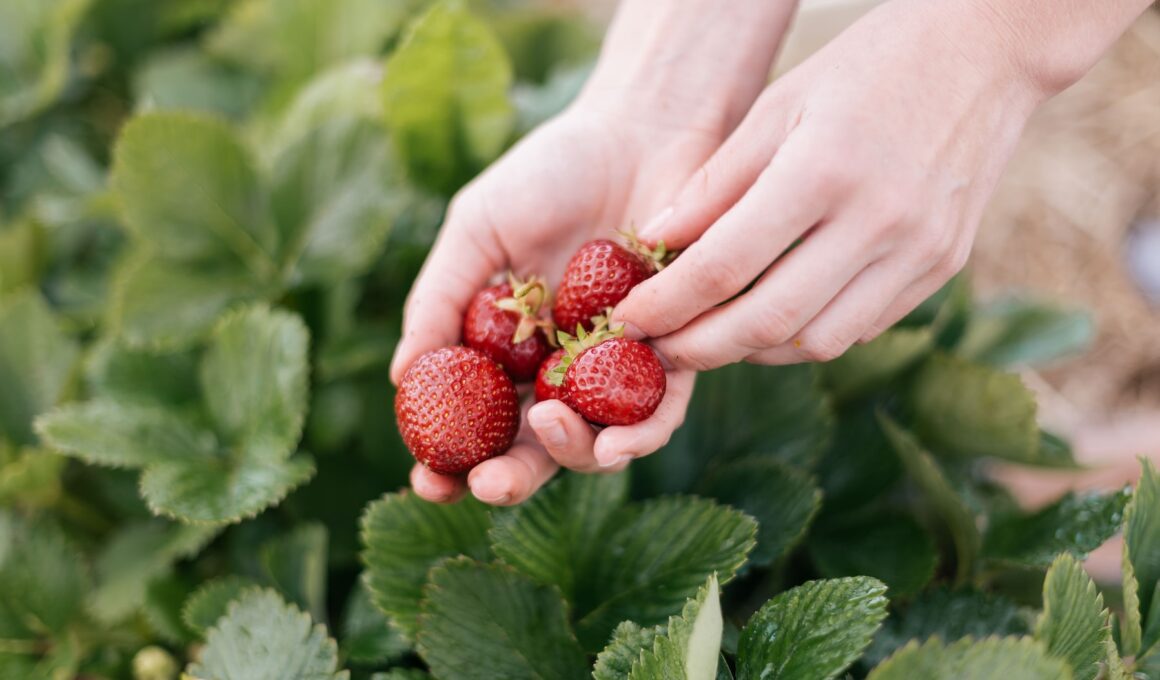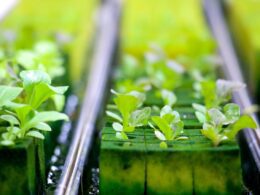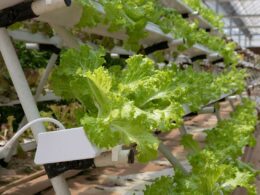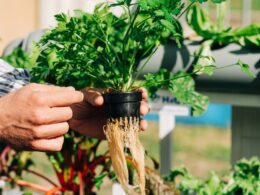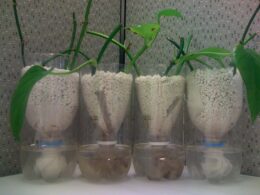Are your hydroponic strawberries not thriving as they should be? Are they showing signs of wilting or yellowing leaves? It can be frustrating to put in the effort and time to grow your own strawberries, only to see them struggling or dying.
But don’t worry, there are solutions to help save your precious plants. In this article, you will learn about the specific needs of hydroponic strawberries, how to identify common pests and diseases, and how to implement preventative measures to ensure your plants stay healthy. Additionally, we will provide troubleshooting tips for common problems you may encounter while growing hydroponic strawberries.
With this knowledge, you will be able to take action and give your plants the best chance of survival.
Understand the Specific Needs of Hydroponic Strawberries
You’ll love learning about the unique requirements that hydroponic strawberries need to thrive!
To start, optimal nutrients are crucial for the success of your hydroponic strawberries. Specifically, they require a balanced mix of nitrogen, phosphorus, and potassium, but also need calcium, magnesium, and iron. Make sure to check the nutrient composition of your hydroponic solution and adjust it accordingly to ensure that your strawberries are receiving the nutrients they need.
Another important factor to consider is the lighting requirements for hydroponic strawberries. They need at least 12 hours of light per day, and the light should be between 400-600 nanometers for optimal growth. It’s best to use LED grow lights for hydroponic strawberries, as they’re energy-efficient and can be adjusted to the specific light spectrum needed for your plants.
In addition to optimal nutrients and lighting, pH levels and temperature control are also critical for hydroponic strawberry success. The pH level should be between 5.5-6.5, and the temperature should be around 60-70 degrees Fahrenheit.
Finally, harvesting techniques and timing are important to ensure that your strawberries are picked at the right time and in the right way. Be sure to pick them when they’re fully ripe, but not over-ripe or under-ripe, and use clean, sharp scissors to cut the stem at the base of the fruit.
By following these tips, you’ll be well on your way to growing delicious hydroponic strawberries!
Identify Common Pests and Diseases
If you’re growing hydroponic strawberries, it’s important to be aware of common pests and diseases that can harm your plants.
Two common pests to watch out for are spider mites and aphids, which can both cause damage to the leaves and fruit.
Additionally, root rot and powdery mildew are two diseases that can affect the health of your plants and should be addressed promptly to prevent further damage.
Spider Mites and Aphids
Looks like those pesky spider mites and aphids have been causing some trouble in your hydroponic setup. These tiny insects can cause major damage to your strawberry plants by sucking the sap from the leaves and stems, leaving behind a trail of destruction. But don’t worry, there are ways to combat these pests before they completely take over.
Here are some tips to help you get rid of spider mites and aphids in your hydroponic system:
-
Natural remedies: Try using neem oil, insecticidal soap, or a mixture of water and dish soap to spray on the affected areas.
-
Chemical treatments: If natural remedies don’t work, you can try using chemical insecticides specifically designed for spider mites and aphids. Just be sure to follow the instructions carefully to avoid damaging your plants or harming yourself.
-
Prevention: To avoid future infestations, regularly inspect your plants for any signs of pests and remove any infected leaves or stems immediately. You can also introduce beneficial insects like ladybugs or lacewings to your hydroponic setup, as they prey on spider mites and aphids.
By taking these steps, you can keep your strawberries healthy and thriving.
Root Rot and Powdery Mildew
Your roots may be rotting and your leaves covered in powdery mildew, causing damage to your plants. Root rot occurs when the roots of your strawberries are exposed to too much moisture, leading to a lack of oxygen and the growth of harmful bacteria and fungi. To prevent root rot, it’s important to use proper watering techniques. Make sure to only water your plants when the top inch of soil is dry, and avoid overwatering. Additionally, ensure that your hydroponic system has adequate drainage to prevent water from sitting stagnant around the roots.
Powdery mildew, on the other hand, is a fungal disease that affects the leaves and stems of your strawberries. It appears as a white, powdery substance on the surface of your plants, hindering their ability to photosynthesize and grow. To identify and treat powdery mildew, regularly inspect your plants for any signs of the disease. If you do spot it, remove any infected leaves immediately and treat the remaining plant with a fungicide. Proper air circulation and humidity control can also help prevent the spread of powdery mildew.
By being proactive in preventing root rot and addressing powdery mildew, you can keep your hydroponic strawberries healthy and thriving.
Implement Preventative Measures
To ensure the longevity of your future hydroponic plants, implementing preventative measures is crucial. Prevention is always better than cure, and you can avoid common issues like root rot and powdery mildew by taking steps to protect your plants.
One of the best preventative strategies is to ensure that your growing medium is sterile before planting. This will help to prevent any harmful bacteria or fungi from taking hold and causing problems.
Another important preventative measure is to maintain a clean and well-ventilated growing environment. Regularly clean your equipment and growing area to prevent the build-up of bacteria or fungi. Additionally, ensure that your plants have plenty of air circulation, as stagnant air can promote the growth of harmful microorganisms.
By keeping your growing environment clean and well-ventilated, you’ll be able to nip any potential issues in the bud before they become a problem.
Lastly, it’s important to have a plan for future growth. This means having a solid understanding of the requirements of your plants and being prepared to adjust your setup as necessary. For example, if you notice that your plants are struggling to get enough light, you may need to invest in additional grow lights.
By staying proactive and vigilant, you’ll be able to prevent issues from occurring and ensure that your hydroponic strawberries thrive.
Troubleshoot Common Problems
If you’re experiencing drooping or yellowing leaves in your hydroponic garden, it could be a sign of overwatering or nutrient deficiencies.
Similarly, a lack of fruit production may indicate a lack of pollination or inadequate lighting.
Wilting or dying plants may be caused by root rot or pest infestations.
By troubleshooting these common problems, you can ensure the health and productivity of your hydroponic plants.
Drooping or Yellowing Leaves
When leaves on your hydroponic strawberry plants begin to droop or turn yellow, it could be an indication of several potential problems.
One of the most common causes is nutrient deficiencies, which can occur when the plants don’t receive enough of the essential minerals necessary for healthy growth.
Overwatering can also lead to drooping or yellowing leaves, as it can cause oxygen deprivation in the roots and lead to root rot.
To diagnose and treat nutrient imbalances in your hydroponic strawberry plants, you may need to conduct regular water and soil tests to monitor nutrient levels.
Adjusting the pH level of your nutrient solution can also help, as certain minerals are absorbed best at specific pH levels.
Additionally, adjusting the nutrient solution’s concentration can provide the plant with the necessary minerals, while avoiding overfeeding.
In cases of root rot due to overwatering, reducing watering frequency and increasing oxygenation can help the plant recover.
By being proactive in monitoring and addressing nutrient imbalances and overwatering, you can help prevent drooping or yellowing leaves in your hydroponic strawberries.
Lack of Fruit Production
The lack of fruit production in your hydroponic strawberry plants can be frustrating, but don’t worry, there are solutions to address this issue.
One possible reason for your plants not producing fruit could be due to poor pollination techniques. Hydroponic strawberries require pollination to produce fruit, and if this process is not done correctly, it can lead to low or no fruit yield. You can try manually pollinating your plants by using a small brush or cotton swab to transfer pollen from the male flowers to the female flowers. Alternatively, you can introduce pollinators like bees or bumblebees into your hydroponic system to help with pollination.
Another possible reason for your hydroponic strawberries not producing fruit could be due to nutrient deficiencies. Strawberries require a balanced mix of nutrients, including nitrogen, phosphorus, and potassium, to grow and produce fruit. If your plants are not receiving enough nutrients, they may prioritize growth over fruit production.
You can adjust the nutrient levels in your hydroponic system by monitoring the pH levels and adjusting the nutrient solution accordingly. It’s also important to regularly check the nutrient solution for any imbalances or deficiencies and make corrections as needed.
By addressing these possible causes of lack of fruit production, you can help your hydroponic strawberries thrive and produce a bountiful harvest.
Wilting or Dying Plants
Don’t let wilting plants get you down – there are solutions to help your hydroponic strawberry crop thrive.
One possible reason for wilting plants could be improper watering frequency. Overwatering or underwatering can both cause stress to the plant, leading to wilted or dying leaves. Make sure to check the moisture level of your growing medium regularly, and adjust your watering schedule accordingly.
Another possible cause of wilting or dying plants could be nutrient deficiency. Hydroponic strawberries require specific nutrients in order to grow and produce fruit. Make sure to check the pH levels of your nutrient solution and adjust as needed. If you suspect a nutrient deficiency, consider adding a hydroponic-specific fertilizer to your nutrient solution.
With proper watering frequency and nutrient balance, your hydroponic strawberry plants will be back to thriving in no time.
Seek Professional Help if Necessary
If you’re feeling stuck and unsure of what to do, seeking professional help can be a great way to get your hydroponic strawberry plants back on track. While there are benefits to DIY hydroponic setups, sometimes it’s best to leave it to the experts. Here are a few reasons why seeking professional help may be the right choice for you:
-
You may be dealing with a complex issue that requires specialized knowledge and equipment that you don’t have. A professional can quickly diagnose and treat the problem, saving you time and money in the long run.
-
It can be difficult to determine whether a plant is suffering from a disease, pest infestation, or simply a nutrient deficiency. A professional can identify the root cause of the problem and provide a targeted solution.
-
Seeking professional help may seem like an added expense, but it’s important to weigh the cost against the potential loss of your crop. A professional can help you optimize your setup and prevent future issues, ensuring a healthy and productive harvest.
Don’t let the fear of added expense or perceived failure prevent you from seeking professional help. Remember, your ultimate goal is a thriving hydroponic strawberry crop. By seeking the help of a professional, you can ensure that your plants receive the care and attention they need to thrive.
Frequently Asked Questions
How long does it take for hydroponic strawberries to grow?
If you’re wondering how long it takes for hydroponic strawberries to grow, the answer is that it depends on the harvest timing and optimal conditions.
Generally, it takes about 60-90 days for hydroponic strawberries to reach maturity and be ready for harvest.
To ensure optimal conditions for growth, make sure that your hydroponic system is set up correctly and that the plants are receiving the right amount of light, nutrients, and water.
It’s important to monitor the pH levels and adjust them as needed. Additionally, ensure that the temperature and humidity levels are within the ideal range for strawberry growth.
With these conditions met, your hydroponic strawberries should grow well and be ready for harvest in a timely manner.
Can hydroponic strawberries be grown outdoors?
If you’re thinking of growing hydroponic strawberries outdoors, there are a few things to keep in mind. First, consider the limitations of the outdoors such as weather conditions and pests. It’s important to have a plan in place for pest management to protect your plants from potential damage.
Additionally, keep in mind that outdoor hydroponic systems may have different requirements than indoor systems, such as additional lighting or shading. With proper planning and attention to detail, growing hydroponic strawberries outdoors can be a successful endeavor.
Do hydroponic strawberries require special lighting?
To grow healthy hydroponic strawberries, you need to provide them with the right type of lighting. LED lights are the best choice for hydroponic strawberries as they use less energy and emit less heat compared to fluorescent lights.
Optimal light intensity for hydroponic strawberries is around 600-800 µmol/m²/s. This level of light intensity is crucial for photosynthesis and fruit production. If your hydroponic strawberries are not receiving enough light, they may become weak and spindly, and their leaves may turn yellow.
On the other hand, if they receive too much light, they may become scorched and wilted. Therefore, it’s essential to monitor the light intensity and adjust it accordingly to ensure that your hydroponic strawberries are getting the right amount of light they need to thrive.
How often should hydroponic strawberries be watered?
If you’re growing hydroponic strawberries, it’s important to understand their optimal watering and nutrient requirements for healthy growth. To keep your plants thriving, make sure to water them regularly and monitor the moisture levels in the growing medium.
Typically, hydroponic strawberries require watering every one to two days, depending on the specific system you’re using. However, it’s important not to over-water, as this can lead to root rot and other issues.
In addition to proper watering, make sure to provide your plants with the right balance of nutrients throughout their growth cycle. By exploring the optimal watering and nutrient requirements for hydroponic strawberry growth, you can help ensure healthy, productive plants that will provide you with a bountiful harvest.
Is it possible to grow hydroponic strawberries without using fertilizers?
You may be wondering if it’s possible to grow hydroponic strawberries without using fertilizers. The answer is yes!
There are organic alternatives to traditional fertilizers that can provide your plants with the nutrients they need to thrive. However, it’s important to note that nutrient deficiencies can still occur if you’re not providing your plants with the right balance of nutrients.
Be sure to regularly test the nutrient levels in your hydroponic system and adjust accordingly. With the right care and attention, you can successfully grow healthy and delicious strawberries without relying on synthetic fertilizers.
Conclusion
So, you’ve been having trouble with your hydroponic strawberries. Don’t worry, it happens to the best of us.
The good news is that there are many things you can do to prevent and troubleshoot common issues.
First, make sure you understand the specific needs of hydroponic strawberries. This includes factors such as pH levels, nutrient ratios, and lighting requirements.
Next, be on the lookout for common pests and diseases that can affect your plants. Implement preventative measures to avoid these issues, such as using beneficial insects or regularly cleaning your system.
If you do encounter problems, don’t give up hope. Troubleshoot the issue by checking for common causes, such as over or under watering, nutrient deficiencies, or improper lighting.
And if all else fails, don’t hesitate to seek professional help. With a little bit of knowledge and some dedication, you can have a thriving hydroponic strawberry garden in no time.





